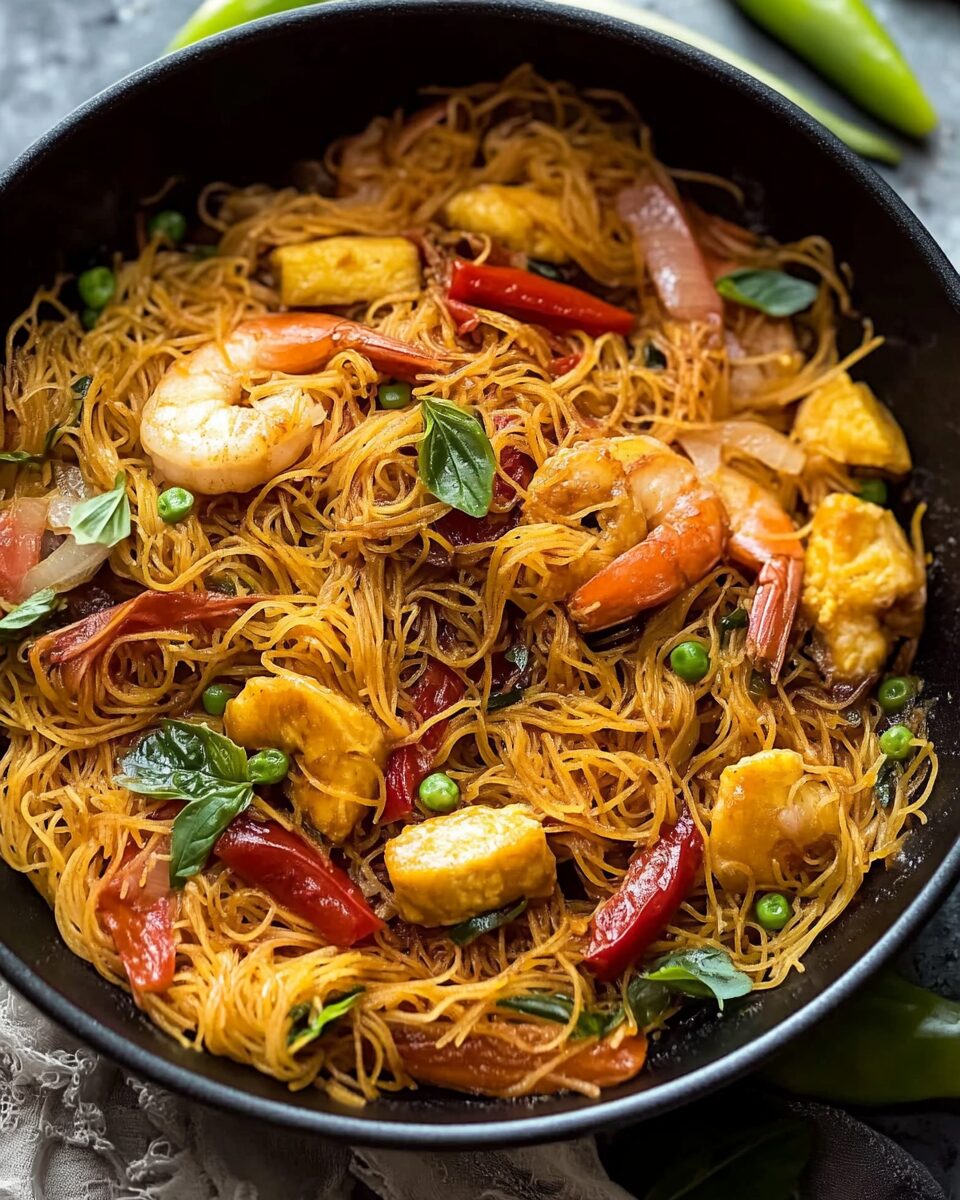The rich aroma of curry powder hits your senses first, followed by the sizzle of shrimp and sweet BBQ pork in a hot wok. Singapore Noodles are a delightful fusion of flavor and simplicity, perfect for a quick, satisfying meal that never compromises on taste. The golden noodles soak up a savory sauce, while crisp bell peppers and egg ribbons bring color and texture to the plate.
This dish is not authentically Singaporean, but it has earned its place as a takeout favorite across the globe. Loved for its bold flavors and ease of customization, Singapore Noodles are perfect for weeknight dinners or lazy weekend meals. Whether you stick to shrimp and pork or throw in what’s in your fridge, the result is always a crowd-pleaser.
Full Recipe:
-
2 tbsp soy sauce
-
2 tbsp Chinese cooking wine (or dry sherry/sake)
-
2½ tsp curry powder (hot or mild)
-
½ tsp sugar
-
½ tsp white pepper (or black)
Stir Fry:
-
100g dried rice vermicelli noodles
-
2 tbsp peanut oil, divided
-
8–10 medium shrimp/prawns, shelled and deveined
-
2 eggs, beaten
-
½ medium onion, thinly sliced
-
4 garlic cloves, minced
-
1 tsp freshly grated ginger
-
250g Chinese BBQ pork (Char Siu), thinly sliced
-
1 cup red bell pepper (capsicum), thinly sliced
-
2 tsp hot green chili, thinly sliced (optional)
Directions:
-
Mix all sauce ingredients in a bowl and set aside.
-
Soak vermicelli noodles in a large bowl of boiled water as per package instructions. Drain and set aside.
-
Heat 1 tbsp oil in a wok over medium heat. Sauté shrimp for about 3 minutes until just cooked. Remove and set aside.
-
Add beaten eggs to the wok, swirl into a thin omelette. Once set, roll up and remove. Slice into strips.
-
Add remaining 1 tbsp oil to the wok. Sauté garlic, ginger, and onion for 2 minutes until slightly softened.
-
Toss in bell pepper, stir-fry for 1 minute.
-
Add noodles and sauce. Stir to combine.
-
Add shrimp, egg, pork, and chili. Stir-fry until everything is heated through and well-coated with sauce (1–2 minutes).
-
Serve hot and enjoy immediately.
Prep Time: 10 minutes | Cooking Time: 10 minutes | Total Time: 20 minutes
Kcal: ~450 kcal | Servings: 2 generous servings
What Are Singapore Noodles?
Singapore Noodles, despite the name, are not actually from Singapore. This colorful stir-fry dish has become a global favorite, especially in Western Chinese takeout menus. Its signature features include thin rice vermicelli noodles tossed with a vibrant yellow curry powder, juicy shrimp, slices of Chinese BBQ pork (Char Siu), scrambled eggs, and vegetables like bell peppers and onions.
With its harmonious blend of textures and flavors, Singapore Noodles bring together sweet, spicy, salty, and umami notes in every bite. The dish is incredibly aromatic and visually striking, often served with a golden hue from the curry powder, contrasting with the reds of capsicum and greens of optional chili or scallion garnish.
The Origins and Misconceptions
One of the most fascinating aspects of Singapore Noodles is the misdirection in its name. While many believe it hails from the Southeast Asian nation of Singapore, this dish is virtually unknown there. In fact, if you were to ask a Singaporean about “Singapore Noodles,” you’d likely get a puzzled look in return.
The dish is believed to have been invented in Chinese restaurants overseas—most notably in Hong Kong or among Chinese diasporas in Western countries. It gained traction on the menus of Cantonese-style Chinese restaurants around the world, becoming a beloved staple for its bold, adaptable flavor profile. Over time, it became known as a crowd-pleaser and a culinary paradox: a “Singaporean” dish that isn’t from Singapore.
Flavor Profile and Ingredients Harmony
At the heart of Singapore Noodles is the interplay between curry powder and soy sauce. The curry adds warmth and earthiness, while soy sauce brings umami depth. Chinese cooking wine (Shaoxing wine) enhances the aroma, while sugar balances out the savory flavors.
Protein is a key component, often combining seafood and meat. The shrimp brings a light, oceanic sweetness, while the Char Siu adds a caramelized, smoky depth. Eggs, cooked into a soft omelette and sliced into ribbons, add richness and a fluffy texture. Bell peppers offer crunch and sweetness, contrasting with the soft rice noodles that absorb all the flavorful sauces.
This balance of textures—crispy veggies, tender meat, juicy shrimp, and soft noodles—makes each forkful dynamic and satisfying.
Adaptability: The Real Secret to Its Popularity
What truly makes Singapore Noodles shine is its incredible versatility. The recipe is forgiving and can be tailored based on what you have on hand. While traditional versions include shrimp and BBQ pork, it’s just as delicious with chicken, bacon, ham, or even tofu for a vegetarian twist.
Don’t have red bell peppers? Swap in carrots, snow peas, cabbage, or bean sprouts. No Chinese cooking wine? Use dry sherry, mirin, or even chicken broth for a non-alcoholic substitute.
Even the noodles are adaptable—though thin rice vermicelli is the traditional base, you can experiment with glass noodles, soba, or even spaghetti if you’re in a pinch. The key is achieving the right texture and flavor balance.
This flexibility is why Singapore Noodles are so popular in home kitchens. You can easily turn it into a one-pan meal with whatever ingredients you have lying around, making it a perfect solution for weeknight dinners or using up leftovers.
Cultural Relevance and Global Appeal
Singapore Noodles reflect the culinary fusion that has become characteristic of global cuisine today. Much like other “inauthentic” favorites—like General Tso’s Chicken or Chicken Tikka Masala—it carries a story of migration, adaptation, and cultural reinterpretation.
The use of curry powder is particularly notable, as it bridges Indian and Chinese culinary traditions. While not a common seasoning in traditional Chinese cuisine, curry powder is often used in Hong Kong-style or Western-Chinese dishes to add boldness and a hint of spice that appeals to a wider audience.
This globalized identity makes Singapore Noodles appealing to diners from all backgrounds. Whether you find it in a food court in Sydney, a Chinese takeout menu in Toronto, or a trendy fusion bistro in London, its bright color and bold taste stand out.
Tips for the Perfect Singapore Noodles
Even though it’s a quick-cooking dish, a few pro tips can elevate your Singapore Noodles from good to restaurant-quality:
-
Prep everything before you cook: Stir-fries move fast, so have all your ingredients sliced, mixed, and ready to toss in the wok.
-
Use high heat: A hot wok ensures everything cooks quickly and develops the desired “wok hei” (breath of the wok), adding a subtle smoky flavor.
-
Don’t overcook the noodles: Rice vermicelli only needs a brief soak in hot water. Overcooking makes them mushy, which ruins the texture.
-
Toss, don’t stir: Use lifting and tossing motions to coat noodles evenly without breaking them.
-
Customize with spice: If you like it hot, add a touch of chili oil, fresh sliced chilies, or sambal oelek for extra heat.
Nutritional Benefits and Considerations
Singapore Noodles can be relatively healthy, especially when loaded with vegetables and lean proteins. Rice vermicelli is gluten-free, making this dish naturally suited for gluten-sensitive diets—just be sure to use a gluten-free soy sauce and check labels on curry powder.
Each serving is generally moderate in calories, especially if you go light on oil and add more vegetables. The dish provides a balance of carbs, protein, and fats, offering sustained energy. That said, due to soy sauce and BBQ pork, it can be high in sodium, so it’s worth being mindful if you’re watching salt intake.
For a lower-carb version, you could use spiralized zucchini or shirataki noodles as a base. And if you’re vegetarian or vegan, simply omit the shrimp and Char Siu or replace them with tofu and mushrooms for a satisfying alternative.
Singapore Noodles as a Meal Prep Favorite
Another reason Singapore Noodles are beloved by home cooks is their meal-prep friendliness. The dish keeps well in the fridge for several days, making it a great choice for lunches or quick dinners.
To store, let it cool completely before sealing in airtight containers. It reheats well in a microwave or stovetop skillet with a splash of water or broth to keep the noodles from drying out.
You can even double the batch and portion it out, ensuring you always have something delicious and satisfying ready to go.
Why You Should Try Singapore Noodles Tonight
Whether you’re a busy professional looking for a quick dinner, a food lover craving something bold and spicy, or a home cook trying to clean out the fridge, Singapore Noodles have something for everyone.
They’re quick, flavorful, customizable, and a little bit nostalgic for anyone who grew up eating Chinese takeout. And the best part? You can make them right at home in under 30 minutes with pantry staples and a hot pan.
If you’ve never made them before, this is your sign. Once you do, they just might become your go-to noodle fix.
Conclusion: A Dish that Tells a Story
Singapore Noodles are more than just a tasty stir-fry—they’re a culinary story. A tale of cultural fusion, adaptability, and comfort food reinvented. With its bold curry aroma, savory proteins, and vibrant colors, it’s a dish that invites you to enjoy the journey as much as the destination.
Whether you follow the traditional combination of shrimp and BBQ pork or go off-script with your own mix of ingredients, Singapore Noodles are sure to satisfy. They embody the very essence of modern cooking—flavorful, flexible, and globally inspired.
Add them to your regular recipe rotation, experiment with different proteins and vegetables, or serve them up for friends and family. One thing’s for sure: Singapore Noodles may not be from Singapore, but they’ve earned a place in kitchens around the world.





